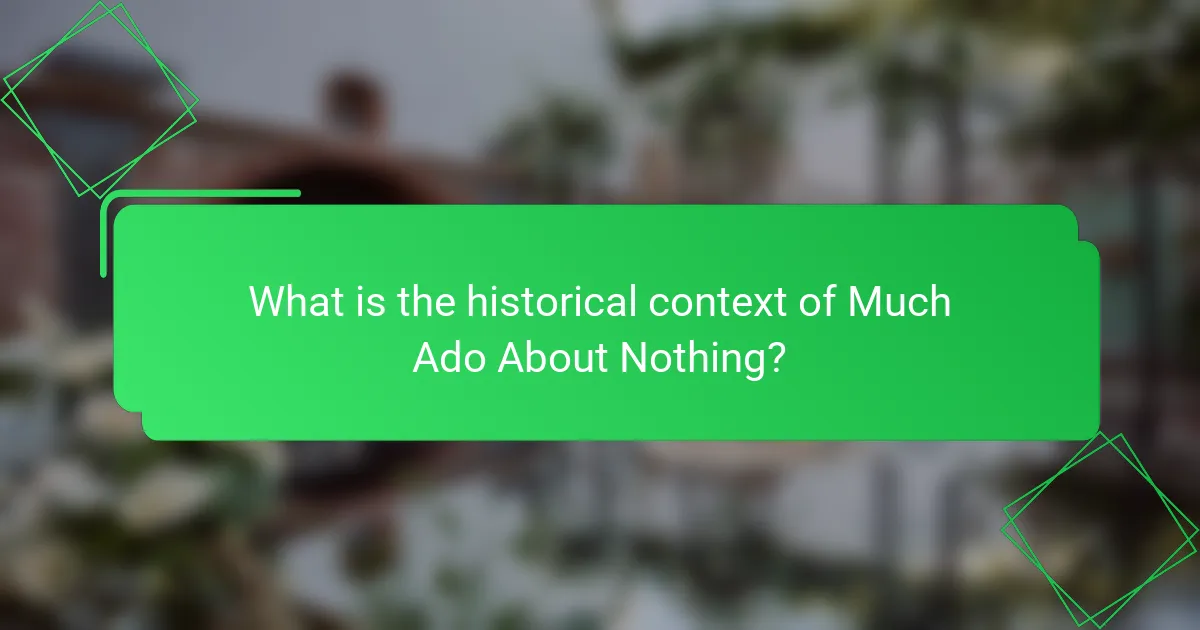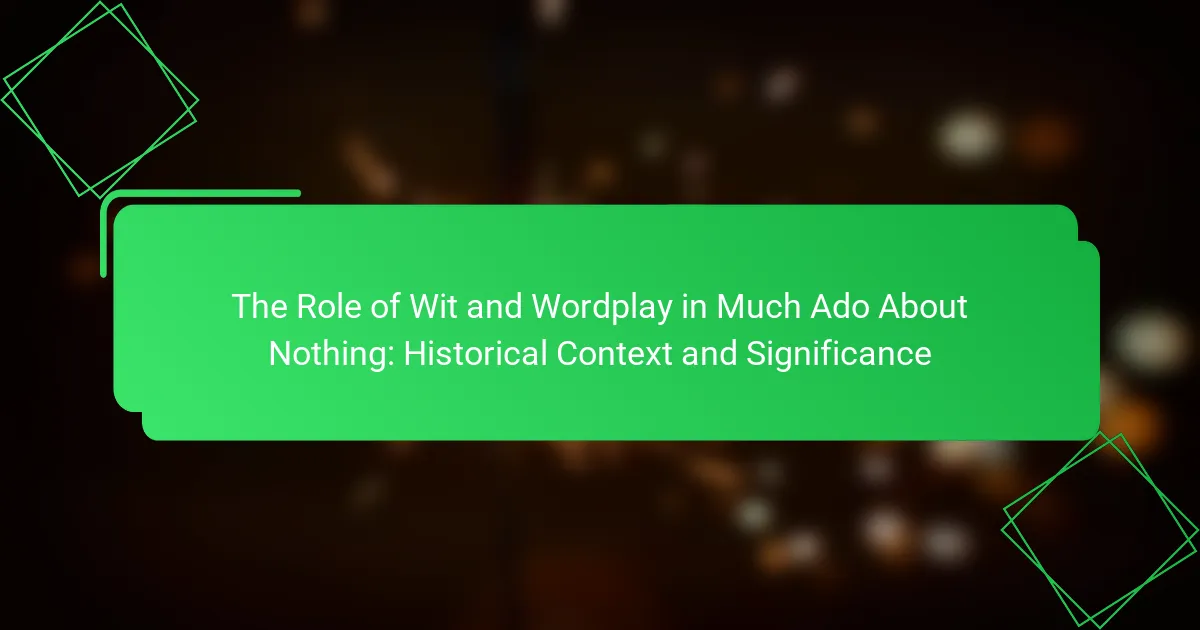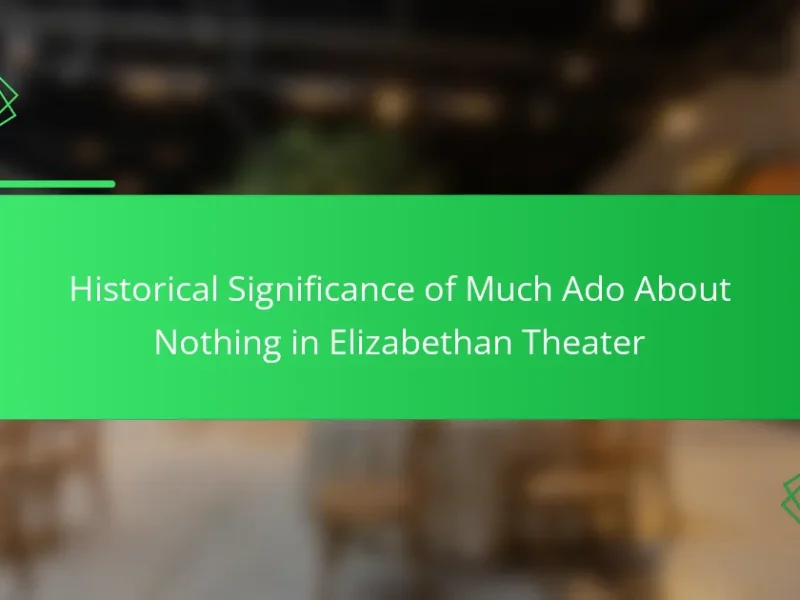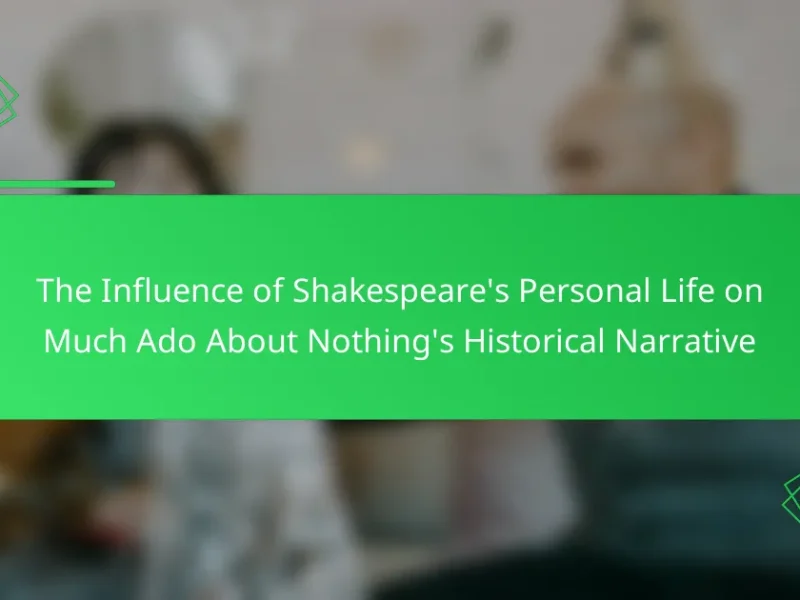
What is the role of wit and wordplay in Much Ado About Nothing?
Wit and wordplay play a crucial role in Much Ado About Nothing. They serve to develop character relationships and advance the plot. The banter between Beatrice and Benedick showcases their intelligence and establishes their romantic tension. Wordplay also highlights themes of deception and misunderstanding. For example, puns and clever dialogue create comedic situations. Wit often acts as a social tool, allowing characters to navigate complex social dynamics. The use of language reflects the Elizabethan context, where verbal dexterity was highly valued. Overall, wit and wordplay enrich the narrative and engage the audience.
How does wit enhance character interactions in the play?
Wit enhances character interactions in the play by adding depth and complexity to dialogue. It fosters quick exchanges that reveal character traits and motivations. Characters use wit to establish social hierarchies and navigate relationships. For instance, Beatrice and Benedick’s banter showcases their intelligence and mutual attraction. This clever wordplay creates tension and humor, engaging the audience. Wit also serves as a tool for deception and misunderstanding, driving the plot forward. The use of puns and double entendres contributes to the richness of the text. Overall, wit elevates character dynamics, making interactions more engaging and memorable.
What specific examples of wit are found in Much Ado About Nothing?
Much Ado About Nothing contains several specific examples of wit. One notable instance is the banter between Beatrice and Benedick. Their exchanges showcase sharp wordplay and clever insults. For example, Beatrice calls Benedick “the prince’s jester,” implying he is foolish. Benedick retorts by saying Beatrice is “a rare parrot,” suggesting she talks too much. Another example occurs during the masked ball. Characters engage in playful deception and mistaken identities, leading to humorous misunderstandings. Additionally, Dogberry’s malapropisms provide comic relief. His misuse of words highlights the absurdity of his character. These examples illustrate the clever use of language throughout the play.
How do characters respond to wit and wordplay throughout the narrative?
Characters in “Much Ado About Nothing” respond to wit and wordplay with humor, admiration, and sometimes confusion. The use of clever banter showcases their intelligence and social status. For instance, Beatrice and Benedick engage in a battle of wits, reflecting their strong personalities and mutual attraction. Their exchanges are filled with puns and repartee, demonstrating their quick thinking. Other characters, like Claudio, often react with surprise or offense to wordplay, highlighting their differing levels of wit. This variation in responses enriches the narrative and emphasizes themes of love and misunderstanding. The playful language serves to deepen relationships and create tension, ultimately driving the plot forward.
Why is wordplay significant in the themes of Much Ado About Nothing?
Wordplay is significant in the themes of Much Ado About Nothing because it highlights the complexities of communication and relationships. The play uses puns and double entendres to explore misunderstandings and deceptions. Characters like Benedick and Beatrice engage in witty banter, showcasing their intelligence and sparking romance. This wordplay also serves to critique societal norms and expectations. For example, misunderstandings arising from wordplay drive the plot’s conflict and resolution. The clever dialogue reflects the characters’ personalities and motivations. Overall, wordplay enriches the narrative by intertwining humor with deeper themes of love and honor.
What themes are explored through the use of wordplay?
Wordplay in literature explores themes such as love, deception, and identity. In “Much Ado About Nothing,” characters use puns and clever language to convey romantic feelings. This highlights the playful nature of love and courtship. Additionally, wordplay reveals deception among characters, showcasing misunderstandings and manipulation. The witty exchanges also emphasize the duality of identity, as characters often mask their true selves. Such themes reflect societal norms and human relationships in the Elizabethan era. Overall, wordplay serves as a vehicle for deeper commentary on these themes.
How does wordplay contribute to the comedic elements of the play?
Wordplay enhances the comedic elements of the play by creating humor through clever language use. Characters engage in puns, malapropisms, and double entendres that provoke laughter. For example, Benedick and Beatrice frequently exchange witty banter filled with wordplay. This sharp dialogue highlights their intelligence and establishes their dynamic relationship. Additionally, misunderstandings stemming from wordplay create situational comedy. The use of language showcases Shakespeare’s mastery in crafting humor. Such techniques keep the audience entertained while also advancing the plot. Overall, wordplay is essential for building comedic tension and engaging the audience.

What is the historical context of Much Ado About Nothing?
Much Ado About Nothing was written during the Elizabethan era, specifically around 1598-1600. This period was marked by a flourishing of English drama and literature. The play reflects social norms, including gender roles and courtship practices of the time. It also showcases the significance of wit and wordplay, which were highly valued in Elizabethan society. The historical context includes the influence of Italian commedia dell’arte, which inspired the play’s comedic elements. Additionally, the political climate of England under Queen Elizabeth I contributed to themes of loyalty and honor. The interplay of love and deception in the play mirrors societal expectations of relationships during this era.
How does the Elizabethan era influence the play’s use of language?
The Elizabethan era significantly influences the play’s use of language through its emphasis on wit and wordplay. During this time, language was a vital tool for social status and intellect. Playwrights like Shakespeare utilized puns, metaphors, and clever dialogue to engage audiences. The era valued rhetorical skill, which is evident in the characters’ exchanges. For instance, Much Ado About Nothing features sharp banter between Beatrice and Benedick, showcasing the era’s appreciation for verbal dexterity. Additionally, the use of iambic pentameter reflects the poetic tradition of the time. This structure allows for rhythmic and expressive dialogue, enhancing the play’s emotional depth. Overall, the Elizabethan context shaped the play’s linguistic style, making it rich in humor and complexity.
What linguistic features were prominent during Shakespeare’s time?
During Shakespeare’s time, prominent linguistic features included the use of iambic pentameter and a rich vocabulary. Iambic pentameter consists of five pairs of unstressed and stressed syllables. This meter created a rhythmic flow in poetry and plays. Additionally, the vocabulary of the period was expansive, incorporating many new words and phrases. Shakespeare himself is credited with coining numerous terms still in use today. The use of puns and wordplay was also significant, adding layers of meaning to dialogue. These features contributed to the complexity and artistry of Shakespeare’s works.
How did societal norms shape the themes of wit and wordplay?
Societal norms significantly influenced the themes of wit and wordplay in literature. In the Elizabethan era, societal expectations dictated behavior and communication. Wit became a tool for navigating social hierarchies and expressing dissent. Wordplay allowed characters to convey deeper meanings while adhering to decorum. The interplay of language reflected societal values, such as honor and reputation. For instance, clever banter often masked underlying tensions. This dynamic is evident in Shakespeare’s “Much Ado About Nothing.” The characters use wit to challenge societal norms and assert individuality. Ultimately, societal norms shaped how wit and wordplay were employed to critique and reflect the social landscape.
What impact did Shakespeare’s contemporaries have on Much Ado About Nothing?
Shakespeare’s contemporaries significantly influenced Much Ado About Nothing through their styles and themes. The wit and wordplay in the play reflect the comedic traditions of the time. Notable playwrights like Ben Jonson and Christopher Marlowe shaped the comedic landscape. Their works emphasized clever dialogue and social commentary. The use of puns and repartee in Much Ado mirrors popular theatrical conventions. Additionally, the social dynamics portrayed in the play resonate with the societal norms of Elizabethan England. The exploration of love and deception reflects contemporary themes in literature. Overall, the interplay of wit in Much Ado can be traced back to the influence of Shakespeare’s peers.
Who were the key figures in Shakespeare’s literary circle?
Key figures in Shakespeare’s literary circle included Christopher Marlowe, Ben Jonson, and Robert Greene. Christopher Marlowe was a contemporary playwright known for his blank verse and dramatic works. Ben Jonson was a prominent playwright and poet who became a rival and friend of Shakespeare. Robert Greene was an early critic of Shakespeare, noted for his pamphlet attacking him. These individuals significantly influenced the theatrical landscape of the time. Their works and interactions helped shape the development of English drama during the Elizabethan era.
How did their works reflect or contrast with Shakespeare’s use of wit?
Many playwrights of Shakespeare’s time employed wit similarly, yet some contrasted sharply with his style. For instance, Ben Jonson’s works often featured more satirical and pointed humor. Jonson’s wit was sharper and aimed at social commentary, unlike Shakespeare’s more playful and romantic approach. In contrast, Christopher Marlowe’s use of wit was more dramatic and intense. Marlowe’s characters often displayed a darker, more existential form of wit. Shakespeare’s wit frequently involved puns and clever wordplay, while Jonson and Marlowe focused on character-driven humor. This distinction illustrates how Shakespeare’s wit was more inclusive and multifaceted, appealing to a broader audience.

What is the significance of wit and wordplay in the broader context of literature?
Wit and wordplay are significant in literature as they enhance themes, character development, and audience engagement. They often serve as tools for social commentary and critique. In works like Shakespeare’s “Much Ado About Nothing,” wit reveals character traits and motivations. Wordplay creates humor and levity, making serious themes more accessible. Historical context shows that wit was valued in Elizabethan society for its intellectual appeal. Additionally, studies indicate that clever language can deepen reader investment in narratives. Overall, wit and wordplay contribute to the richness and complexity of literary works.
How have later works been influenced by Shakespeare’s use of wit?
Shakespeare’s use of wit has significantly influenced later works in literature and drama. His clever wordplay and sharp repartee set a standard for comedic dialogue. Many playwrights and authors have emulated his style to create engaging interactions between characters. For example, Oscar Wilde’s “The Importance of Being Earnest” showcases similar wit and irony. Additionally, modern television comedies often draw inspiration from Shakespearean banter. The quick exchanges in shows like “Friends” reflect this influence. Overall, Shakespeare’s wit has shaped the evolution of humor in storytelling across various genres.
What modern examples reflect Shakespearean wit and wordplay?
Modern examples that reflect Shakespearean wit and wordplay include the television show “The Office.” The characters often engage in clever banter and puns reminiscent of Shakespeare’s dialogue. Another example is the film “10 Things I Hate About You,” which features sharp dialogue that plays with language in a way similar to Shakespeare’s comedies. Additionally, the musical “Something Rotten!” directly references Shakespearean themes and incorporates wordplay throughout its narrative. These examples demonstrate how contemporary media continues to embrace the cleverness and linguistic playfulness found in Shakespeare’s works.
How do contemporary authors utilize similar techniques in their writing?
Contemporary authors utilize similar techniques in their writing by incorporating wit and wordplay. They often use puns, double entendres, and clever dialogue to engage readers. This technique creates humor and adds depth to character interactions. For example, authors like David Foster Wallace and Zadie Smith employ playful language to explore complex themes. Their use of wit mirrors Shakespeare’s approach in “Much Ado About Nothing.” Both utilize language to enhance storytelling and provoke thought. This connection highlights the enduring relevance of wordplay in literature across time.
What can we learn from Much Ado About Nothing regarding the use of wit today?
Much Ado About Nothing teaches us that wit can be a powerful tool for communication. Wit fosters connection and engagement among individuals. The play showcases how clever banter can reveal character traits and social dynamics. For example, Beatrice and Benedick’s exchanges highlight their intelligence and mutual attraction. This demonstrates that wit can enhance relationships and build rapport. Additionally, the play illustrates the potential for wit to mask deeper emotions. Characters often use humor to deflect vulnerability. This suggests that wit can serve both as a defense mechanism and a means of expression. Overall, the play emphasizes the relevance of wit in navigating social interactions today.
How can wit and wordplay enhance communication in modern contexts?
Wit and wordplay enhance communication by making interactions more engaging and memorable. They can convey complex ideas in a concise manner. Humor often captures attention and fosters a connection between communicators. In modern contexts, witty remarks can break the ice in social situations. Wordplay adds layers of meaning, encouraging deeper thinking. Studies show that humor can improve retention of information. For example, a 2017 study in the Journal of Applied Psychology found that humor in presentations increased audience engagement. Overall, wit and wordplay facilitate clearer and more enjoyable exchanges.
What are practical tips for incorporating wit in writing or dialogue?
Incorporating wit in writing or dialogue can enhance engagement and humor. Use wordplay, such as puns or double entendres, to create clever twists. Employ timing effectively; a well-placed joke can amplify its impact. Observe real conversations; this can inspire authentic and relatable dialogue. Utilize irony to contrast expectations with reality, adding depth to your writing. Keep it concise; brevity can make witty remarks more powerful. Experiment with character voice; distinct personalities can deliver wit uniquely. Finally, revise and refine; editing can sharpen wit and improve clarity. These strategies are supported by literary examples throughout history, such as Shakespeare’s use of wit in “Much Ado About Nothing.”
The main entity of the article is “Much Ado About Nothing,” a play by William Shakespeare. The article explores the crucial role of wit and wordplay within the narrative, examining how these elements develop character relationships, enhance comedic elements, and reflect the historical context of the Elizabethan era. Key themes include the complexities of communication, the impact of societal norms on language, and the significance of clever dialogue in advancing the plot. Specific examples of wit, character interactions, and the influence of Shakespeare’s contemporaries are also discussed, highlighting the enduring relevance of these techniques in both historical and modern contexts.


